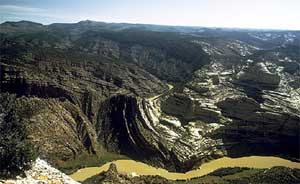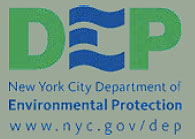Contains the keyword government
The official birthday of EPA is December 2, 1970. Like any other birth, EPA's needed progenitors, and a family tree stretching back for years. Surely no factor was more pivotal in the birth of EPA than decades of rampant and highly visible pollution. But pollution alone does not an agency make. Ideas are needed--better yet a whole world view--and many environmental ideas first crystallized in 1962.
That year saw the publication of Rachel Carson's Silent Spring, first in serial form in the New Yorker and then as a Houghton Mifflin best seller. This exhaustively researched, carefully reasoned, and beautifully written attack on the indiscriminate use of pesticides was not exactly light reading. Yet it attracted immediate attention and wound up causing a revolution in public opinion.
An inveterate bird-watcher, Carson derived her missionary zeal from her fear that fewer species of birds would be singing each spring unless pesticide poisoning was curtailed. The readers of her book, however, were less alarmed by the prospect of a "Silent Spring" than they were about people dying from any number of hidden poisons lurking in what had previously seemed a benign environment. It was not hard to wax hysterical after reading in Carson's book that "the common salad bowl may easily present a combination of organic phosphate insecticides" that could "interact" with lethal consequences to the unsuspecting salad muncher.
Silent Spring played in the history of environmentalism roughly the same role that Uncle Tom's Cabin played in the abolitionist movement. In fact, EPA today may be said without exaggeration to be the extended shadow of Rachel Carson. The influence of her book has brought together over 14,000 scientists, lawyers, managers, and other employees across the country to fight the good fight for "environmental protection..."
See: EPA History Web Page
See: The Origins of EPA
See: Carson, Rachel. (1962). Silent Spring. Boston: Houghton Mifflin, 2002. Print.
Read the results.
Here's why they did the survey.
There are probably no more important reforms to government than the ones that came with the passing of the Federal Freedom of Information ("FOI") Act. The law recognized in no uncertain terms that if government is to be of the people, by the people and for the people, the decisions and actions of the government must be open for review by the people.
The states, for the most part, followed the federal government in adopting open records laws.
Unfortunately, state FOI laws have proven to be almost uniformly weak and easy to undermine. The weakness and haphazard construction of the state laws has resulted in an information gap that significantly effects the citizenry's ability to examine even the most fundamental actions of government.
| BGA survey of FOI laws |
In the course of numerous investigations, Better Government Association investigators have been refused in our requests to review state contracts and performance measures, denied everything from documentation of ambulance response times to the documents reviewed when making budgeting decisions, and ignored by officials in nearly every major office at one time or another. Our experience told us that the FOI laws simply do not work very well in Illinois.
As a result of our hands-on experience with Illinois' lack of responsiveness, the BGA decided to find out where we stood in relationship to other states. We found that no one had completed any sort of national analysis of FOI laws, and that Illinois' relative strengths and weaknesses could not be measured without creating a new instrument to study the problem and without an analysis of each state's statutory provisions for FOI.
I was looking for the original article and ran this search on Google Scholar.
Analysis conducted by the Better Government Association
Staff: Terrance A. Norton, James M. Newcomb & Jay E. Stewart
Interns: Erika Washington and David Hall
Alabama, Alaska, Arizona, Pennyslvania, Montana, South Dakota, Tennessee, and Wyoming all got a bit fat F.
The Energy Policy Act of 2005 (P.L. 109-58), signed by President Bush on August 8, 2005, was the first omnibus energy legislation enacted in more than a decade. Spurred by rising energy prices and growing dependence on foreign oil, the new energy law was shaped by competing concerns about energy security, environmental quality, and economic growth.
The Energy Policy Act encourages production on federal lands through royalty reductions for marginal oil and gas wells on public lands and the outer continental shelf. Provisions are also included to increase access to federal lands by energy projects — such as drilling activities, electric transmission lines, and gas pipelines.
In addition, the law prevents the Environmental Protection Agency (EPA) from regulating hydraulic fracturing to protect drinking water sources.
(For additional information, see CRS Report RL32873, Key Environmental Issues in the Energy Policy Act of 2005, coordinated by Brent D. Yacobucci, and CRS Report RL32262, Selected Legal and Policy Issues Related to Coalbed Methane Development, by Aaron M. Flynn.)
See: CRS Report RL33302.
Raul Grijalva. January 19, 2006. The Nation. "Coming Clean and Green."
"Much of the progress made over the past four decades in protecting the environment has been reversed by the Bush Administration. Its priorities are clear: The interests of corporate contributors always trump the public's well-being."
This article appeared in the February 6, 2006 edition of The Nation. Raul Grijalva, Chair of the House Democratic Environmental Task Force, has represented Arizona's 7th District since 2003.
U. S. EPA Office of Atmospheric Programs. (2006). Click on Executive Summary (PDF) (26 pp, 310K).
Provides a broad overview of all U.S. greenhouse gas emission sources and sinks, introduces key concepts and discusses the primary drivers for changes in emissions, which has resulted in global warming.
See: Global Warming Frequently Asked Questions
Greenhouse gases Carbon Dioxide (CO2) and Methane (CH4) taken together account for 93% of all emissions, with 85% for (CO2) and 8% for (CH4). Enteric fermentation (flatulence and belching), taking place as a digestive by-product of cows and other ruminant animals accounts for less than half of the Methane emissions. Coal mining and natural gas systems, in addition to the (CO2) emissions of vehicles used to transport water add significantly to the total of all greenhouse gas emissions.
For pie charts graphically showing these percentages, see pages 20-22.
Kurt Repanshek. November 5, 2008. National Parks Traveller.
These and other slices of the public lands landscape deserve some form of protection for visitors today and tomorrow to enjoy. And yet, the outgoing Bush administration is determined to open them to drilling rigs with all their associated access roads, noise, air, and, potentially, water pollution.
How much is too much? When the oil and gas industry in Utah has nearly 3,500 drilling permits in hand, but which have not been acted upon, why is the Bush administration selling them more, particularly in sensitive areas around national parks and monuments?
Conservation groups such as the National Parks Conservation Association, The Wilderness Society, and the Southern Utah Wilderness Alliance warned that the BLM was poised to announce on Election Day that it was ready to sell hundreds of oil and gas drilling leases in the above-cited places as well on lands surrounding Dinosaur National Monument, Arches National Park, and Canyonlands National Park.
But when Election Day arrived, BLM officials merely announced they were opening 360,000 acres to oil and gas work without specifying exactly where those leases would fall.

See: Environment News Service (ENS). Bush-Era Oil and Gas Leases Near Utah Parks Canceled. 2/4/2009.
See: Deseret News. Geoff Liesik and Mary Bernard. "Judge says drilling lease lawsuit too late". Salt Lake City. 9/2/2010.
See:Earthworks: 4/1/2010 "Obama's gifts to extractive industries continue with defense of Bush mining policy".
See: Student Disrupts Government Auction of 150,000 Acres Of Wilderness For Oil & Gas Drilling.
Student Disrupts Government Auction of 150,000 Acres Of Wilderness For Oil & Gas Drilling.
Democracy Now reports on student action by Tim DeChristopher.
In a national broadcast exclusive, University of Utah student Tim DeChristopher explains how he bought 22,000 acres of land in an attempt to save the property from drilling. The sale had been strongly opposed by many environmental groups. Stephen Bloch of the Southern Utah Wilderness Alliance said: "This is the fire sale, the Bush administrations last great gift to the oil and gas industry. This is the first 10 minutes of the interview. For the rest go to DemocracyNow!
 For full interview click here.
For full interview click here.
See: Judge says drilling lease lawsuit too late
See: Tim DeChristopher's blog and update on his legal battle.
See: As climate crime continues, who are we sending to jail? Tim DeChristopher?
An archived Nancy Pelosi blog page.
Americans need Consumer Protection when it comes to Energy and Power.
See The CLEAR Act. (2010): In the wake of the BP disaster, Congress is acting on its commitment to protect America’s families and businesses, rebuild the Gulf Coast, hold BP and oil companies accountable, and work to ensure that a spill of this kind never happens again.
On July 30th, the House passed the CLEAR Act (H.R. 3534) by a vote of 209-193—legislation to effectively prevent and respond to oil spills and protect our coastal communities and waters:
Pelosi has been on it! The MMS has failed us. State monitoring of Horizontal Drilling will not protect consumers. Gas Drilling needs the same Federal scrutiny as Oil Drilling.
Speaker of the U.S. House of Representatives Nancy Pelosi's blog, includes statements by government representatives on 110th congress H.R.6899 Comprehensive American Energy Security and Consumer Protection Act.
The MMS (Minerals and Mining Service) was first brought to my attention through Pelosi's Blog.
Natural Resources Hearing on the Department of Interior Scandal
Thursday, September 18th, 2008 by Karina
Today, the House Natural Resources Committee, led by Chairman Nick J. Rahall, is holding a full Committee oversight hearing on “Recent Interior Department Inspector General Investigations on Federal Oil and Gas Royalty Collections.” Secretary of the U.S. Department of the Interior Dirk Kempthorne and Department of the Interior Inspector General Earl Devaney are testifying. Watch the live webcast.
Reading the minutes of this meeting held on April 28, 2009 led me to many of the significant documents used in the production of my Fracking Guide. Since this meeting a year ago, many other city and county legislatures in New York have adopted similar resoultions. (Neil Zusman, 2010-04-29.)
Resolution by The City of New York Manhattan Community Board No. 3.
Item No. 3 of minutes. Page 4 of 9.
3. Resolution regarding drilling in Marcellus Shale and impact on NYS water supply VOTE: WHEREAS, On July 23, 2008 Governor David Patterson signed A10526/S08169 into law, a bill setting certain technical requirements pertaining to well spacing which will facilitate the use of hydraulic fracturing for natural gas recovery in an under ground geological formation known as the Marcellus Shale...
WHEREAS, serious deficiencies in a review of the effects of hydraulic fracturing on drinking water supplies conducted by the U.S. Environmental Protection Agency (EPA) have been raised, including the alleged removal of key passages in that document by officials from the Office of Vice President Dick Cheney, as reported on October 14, 2004 by the Los Angeles Times, and the characterization of the report as "scientifically unsound" by an internal EPA whistleblower...
THEREFORE, BE IT RESOLVED that Manhattan Community Board #3 unequivocally urges the New York State Department of Environmental Conservation to prohibit the use of hydraulic fracturing in the New York State and especially within the City watershed..."
New York City Department of Environmental Protection. 12/23/2009. Impact Assessment of Natural Gas Production in the New York City Water Supply Watershed. 24 pages.
See: Bruce Stutz. Mar. 25, 2010. "A Contoversial Drilling Practice Hits Roadblock in New York." Yale University. Environment360

















